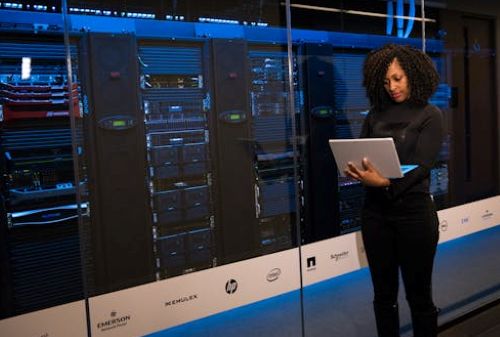

In today’s interconnected world, companies are facing a growing number of sophisticated cyberattacks aimed at exploiting their systems. These threats can have severe consequences, from data breaches to loss of customer trust, making it more important than ever for organizations to implement solid defenses. Cybersecurity is not just about protecting data, it’s about safeguarding every aspect of a company’s operation. However, many companies underestimate the complexity of these attacks and the need for proactive measures. Some breaches are subtle, allowing hackers to infiltrate systems quietly without leaving obvious traces. This makes it crucial for companies to go beyond basic protections and adopt comprehensive strategies that address the full spectrum of potential vulnerabilities.
Here’s how you can safeguard your digital landscape:
Understanding the Basics of Cybersecurity
Before diving into advanced strategies, it’s essential to grasp the fundamentals of keeping a network secure. Cybersecurity involves protecting systems, networks, and sensitive data from unauthorized access, theft, and damage. A good starting point for any organization is developing a security mindset across all levels of operation. Strong access control, proper encryption, and ensuring only authorized users can access sensitive areas are core components. Additionally, it’s crucial to implement regular security checks to identify and address weaknesses early. This proactive approach helps minimize the risk of future intrusions.
Get Professional Security Services
As threats become more sophisticated, many companies turn to cybersecurity professionals who specialize in defending against complex attacks. Professional services can provide tailored security assessments, network monitoring, and advanced protection techniques, offering expertise that in-house teams may lack. One such approach is defending against advanced network infiltration techniques, such as the pass the hash attack. These attacks target vulnerabilities in authentication protocols, enabling attackers to gain unauthorized access without ever needing to crack a password. Security specialists can implement solutions such as strong authentication practices, continuous monitoring, and anomaly detection to minimize these risks.
In response to these evolving threats, many organizations are turning to solutions like Cisco Secure Access, which combine identity-based access control with continuous verification to ensure only trusted users and devices can connect to sensitive resources. By streamlining remote access and enforcing zero trust principles, this approach reduces exposure to potential breaches while maintaining user productivity.
Strengthening Your Password Policies
A company’s first line of defense often lies in its password management policies. Simple, weak passwords are one of the most common vulnerabilities hackers exploit to gain access. Encouraging the use of complex, unique passwords is essential. Also, businesses should implement multi-factor authentication (MFA), which requires users to provide multiple forms of verification before gaining access. Regular password changes, password managers, and avoiding password reuse across platforms are also key strategies. This helps ensure that access to critical systems remains secure even if passwords are compromised elsewhere.
Utilizing Encryption to Protect Data
Encryption is one of the most effective methods for keeping sensitive data safe, whether it’s in storage or being transmitted across networks. By converting information into unreadable code, encryption ensures that even if data is intercepted or accessed by unauthorized parties, it remains unintelligible without the appropriate decryption key. Encryption can be applied to various types of data, including emails, financial records, and customer information. Adopting end-to-end encryption for all communication channels and implementing full disk encryption on devices can significantly reduce the risk of data theft and unauthorized access.
Installing and Updating Antivirus and Anti-malware Software
Antivirus and anti-malware software play a vital role in protecting networks from malicious attacks. These tools are designed to detect, block, and remove viruses, malware, and other harmful programs before they can cause harm. However, simply installing these tools is not enough. They must be regularly updated to stay effective against new and emerging threats. Automated updates ensure that your systems remain protected without requiring manual intervention, allowing your software to adapt to the latest security vulnerabilities and prevent potential breaches. Regular scans and real-time monitoring provide additional layers of defense, helping catch any threats that manage to slip past initial barriers. Dark web monitoring complements these defenses by proactively searching for your compromised information online, adding an essential layer of positive security that alerts you to risks before they impact you directly.
Employee Training and Awareness
While technology plays a significant role in protecting data, employees are often the first line of defense. Unfortunately, human error is one of the most common causes of security breaches. Employees may inadvertently open malicious emails, click on infected links, or fall for phishing scams. Regular training sessions are essential to help staff identify potential threats and learn best practices for keeping data secure. This includes recognizing suspicious emails, not sharing passwords, and understanding the importance of locking their computers when they leave their desks. A well-educated workforce can significantly reduce the risk of attacks, making training an essential part of any cybersecurity strategy.
Backing Up Your Data Regularly
Backing up critical data is a crucial safeguard in the event of a cyberattack, particularly in the case of ransomware. Ransomware encrypts files and demands a ransom to restore access. If a company’s data is backed up regularly and securely, it can restore systems without having to pay the ransom. Regular backups should be performed both on-site and in the cloud to provide redundancy. Ensuring that backups are stored securely and are regularly tested for integrity can save time and resources during recovery efforts. An effective backup plan helps businesses minimize downtime and maintain access to essential data even in the face of an attack.
Implementing Intrusion Detection Systems (IDS)
An Intrusion Detection System (IDS) is designed to monitor network traffic for any signs of suspicious activity or unauthorized access. These systems analyze network patterns and can quickly detect potential threats, providing alerts that allow security teams to respond before significant damage is done. IDS can identify a variety of attacks, including denial-of-service (DoS) attacks, malware, and unauthorized system access attempts. By implementing IDS, businesses can stay ahead of potential threats and mitigate the damage caused by an intrusion. It’s important to continuously monitor and update the IDS to ensure it is effective against evolving attack methods.
Keeping Software and Systems Up-to-Date
Software vulnerabilities are a prime target for cybercriminals looking to exploit weaknesses in a system. Regular software updates and patches are essential to close security gaps. Many attacks occur because businesses fail to update their operating systems, applications, or other software in a timely manner. Companies should prioritize applying patches as soon as they are released to avoid being vulnerable to attacks. This includes everything from operating system updates to third-party software, such as browsers, plugins, and email clients. Automating updates wherever possible can help keep all systems secure without the need for manual intervention, reducing the risk of human error.
Safeguarding your organization against cyberattacks is an ongoing effort that requires a combination of strong technology, proactive monitoring, and employee education. With the right strategies in place, such as utilizing professional security services, strengthening password policies, and investing in regular backups and software updates, businesses can significantly reduce their risk. Cybersecurity is not just about defending against attacks. It’s about creating a culture of vigilance and continuous improvement. By adopting a comprehensive cybersecurity strategy and responding quickly to incidents, businesses can protect their data, maintain trust with customers, and ensure long-term success in an increasingly digital world.


